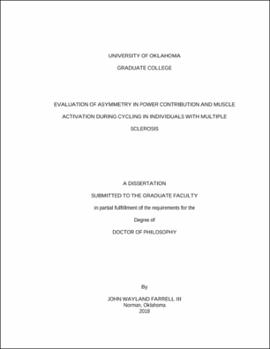| dc.description.abstract | Bilateral asymmetry has emerged as a potential new symptom in persons with Multiple Sclerosis (MS) with previous studies having found significant asymmetries in peak power output (PPO) during single leg cycling and maximal voluntary contraction (MVC) strength. However, asymmetry has only been assessed by testing limbs in an independent manner. PURPOSE: The purpose of the current study was to assess bilateral asymmetry in the contribution to total power output production in persons with MS during double leg cycling. METHODS: Nine volunteers with MS (Females = 4) and 6 healthy controls (Females= 3) participated in the current study. An initial GXT was performed at a Self-Selected (SS) cadence to obtain VO2max and PPO. Subsequent GXTs were individualized to allow participants to exercise at relative exercise intensities ranging from 50 to 100% of PPO. Participants performed GXTs at either a SS, High (20% >SS), or Low (20% < SS) cadence. The contribution of each limb to total power output was assessed via dual power meters. Maximal voluntary isometric strength was assessed for the knee extensors of each of the lower limbs. Walking capacity was assessed via the 25ft walk and 6 minute walk tests. Independent t-tests were used to assess differences in descriptive characteristics, isometric strength asymmetry, and walking capacity. Pearson’s r correlations were performed to determine the relationship between physiological variables collected during the GXTs and walking capacity. Spearman’s correlation was utilized to assess the relationship between Expanded Disability Status Scale (EDSS) score and asymmetry levels. Two-way repeated measures ANOVA were used to detect group x cadence interactions for physiological variables collected during the GXTs. Differences in the contribution to total power production was assessed using a 3 way mixed factorial ANOVA with between (group) and within subject factors (cadence x intensity). RESULTS: No significant differences existed between groups for descriptive characteristics (p>0.05). No significant differences existed between groups and cadence for physiological variables. No significant differences were present for contribution to total power production for each limb between groups, cadence, and exercise intensity (p>0.05). Significant correlations were found between VO2max, PPO, asymmetry during SS GXT, and walking capacity during both FTPs. Significant correlations were found when subjects were pooled together and in the MS group alone. Significant correlations were found between EDSS score and asymmetry levels. CONCLUSIONS: The current study suggests that exercise intensity may not have an impact on bilateral asymmetry during double leg cycling. However, other analysis techniques may provide additional insights that may be masked by traditional statistical analysis. The use of development of thresholds, such as an asymmetry index of 10%, maybe more appropriate to use in an MS cohort. | en_US |
